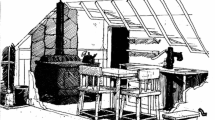Abstract
Pixel-oriented approaches for generating line drawings have been used by several authors in the last years. We extend given G-Buffer based methods by adding a special way of generating hatching lines and subsequently applying half-toning Operations. Hatching lines are created by intersecting the model with a set of planes. Half-toning is done on the basis of hatching lines and corresponding areas for which the appearance of the lines should approximate the given intensity distribution.
This article is a slightly changed preprint of the chapter „Pixel-oriented Rendering of Line Drawings“to be published in the book: Th. Strothotte, H. Wagener (Eds.): „Abstraction in Interactive Computational Visualization — Exploring Complex Information Spaces“, Springer-Verlag, Heidelberg
Access this chapter
Tax calculation will be finalised at checkout
Purchases are for personal use only
Preview
Unable to display preview. Download preview PDF.
Similar content being viewed by others
References
Kellogg S. Booth David R. Forsey, and Alan W. Paeth. Hardware assistance for Z-buffer visible surface algorithms. In M. Green, editor, Proceedings of Graphics Interface’86, pages 194–201, May 1986
E. Catmull. A subdivision Algorithm for Computer Display of Curved Surfaces. PhD thesis, Computer Science Department, University of Utah, Salt Lake City, UT (REPORT UTEC-CSs-74–133), 1974.
W. Leister. Computer generated copper plates. Computer Graphics Forum, 13(l):69–77, 1994.
John Lansdown and Simon Schofield. Expressive rendering: A review of nonphotorealistic techniques. IEEE Computer Graphics and Applications, 15(3):29–37, May 1995.
A. Myers. An efficient visible surface program. Technical report, National Science Foundation, Computer Graphics Research Group, Ohio State University, Columbus, Ohio, 1975.
A. Rosenfeld and A.C. Kak. Digital Picture Processing. Academic Press, 1982.
J. R. Rossignac and A. A. G. Requicha. Depth-buffering display techniques for constructive solid geometry. IEEE Computer Graphics and Applications, 6(9):29–39, 1986.
Michael P. Salisbury, Sean E. Anderson, Ronen Barzel, and David H. Salesin. Interactive pen-and-ink illustration. In Andrew Glassner, editor, Proceedings of SIGGRAPH’94 (Orlando, Florida, July 24–29, 1994), Computer Graphics Proceedings, Annual Conference Series, pages 101–108. ACM SIGGRAPH, ACM Press, July 1994. ISBN 0–89791–667–0.
Mike Salisbury, Corin Anderson, Dani Lischinski, and David H. Salesin. Scale-dependent reproduction of pen-and-ink illustrations. In Holly Rushmeier, editor, SIGGRAPH 96 Conference Proceedings, Annual Conference Series, pages 461–468. ACM SIGGRAPH, Addison Wesley, August 1996. held in New Orleans, Louisiana, 04–09 August 1996.
T. Saito and T. Takahashi. Comprehensive rendering of 3-d shapes. In Computer Graphics (Proc. SIGGRAPH 90), volume 24(4), pages 197–206. ACM SIGGRAPH, ACM Press, 1990.
Greg Turk and David Banks. Image-guided streamline placement. In Holly Rushmeier, editor, SIGGRAPH 96 Conference Proceedings, Annual Conference Series, pages 453–460. ACM SIGGRAPH, Addison Wesley, August 1996. held in New Orleans, Louisiana, 04–09 August 1996.
Georges Winkenbach and David H. Salesin. Computer-generated pen-and-ink illustration. In Andrew Glassner, editor, Proceedings of SIGGRAPH’94 (Orlando, Florida, July 24 – 29, 1994), Computer Graphics Proceedings, Annual Conference Series, pages 91–100. ACM SIGGRAPH, ACM Press, July 1994. ISBN 0–89791–667–0.
Georges Winkenbach and David H. Salesin. Rendering free-form surfaces in pen and ink. In Holly Rushmeier, editor, SIGGRAPH 96 Conference Proceedings, Annual Conference Series, pages 469–476. ACM SIGGRAPH, Addison Wesley, August 1996. held in New Orleans, Louisiana, 04–09 August 1996.
Author information
Authors and Affiliations
Editor information
Editors and Affiliations
Rights and permissions
Copyright information
© 1999 Springer Fachmedien Wiesbaden
About this chapter
Cite this chapter
Deussen, O. (1999). A Pixel-Oriented Approach for Rendering Line Drawings. In: Hagen, H., Brunnet, G.H., Müller, H., Roller, D. (eds) Dagstuhl Seminar 1997. Vieweg+Teubner Verlag, Wiesbaden. https://doi.org/10.1007/978-3-322-89938-5_11
Download citation
DOI: https://doi.org/10.1007/978-3-322-89938-5_11
Publisher Name: Vieweg+Teubner Verlag, Wiesbaden
Print ISBN: 978-3-519-02746-1
Online ISBN: 978-3-322-89938-5
eBook Packages: Springer Book Archive




